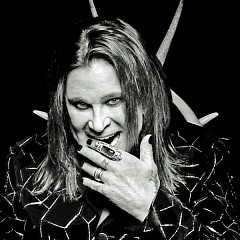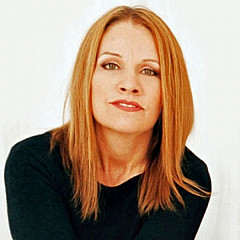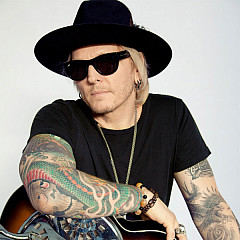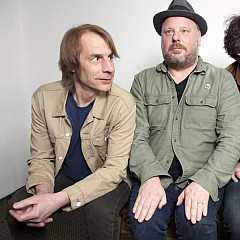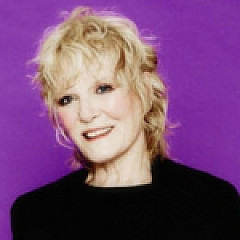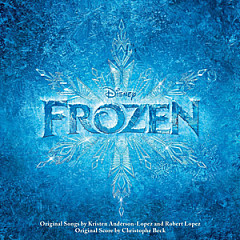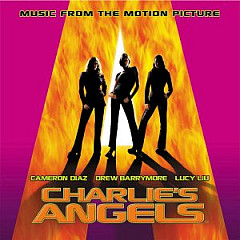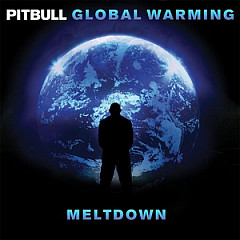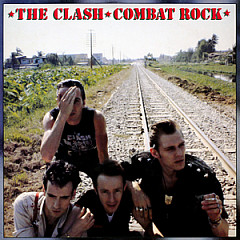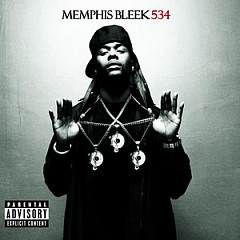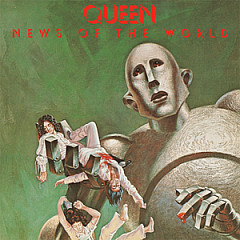Driving the Calexico train are Joey Burns and John Convertino, veterans of the Los Angeles music scene who became part of the rhythm section for Howe Gelb's band, Giant Sand. When Gelb moved the operation to Tucson, Burns and Convertino found inspiration in the sounds of the Southwest and in a used music store where they could haggle a good set of marimbas. They quickly assimilated into the scene and formed their own outfit, which they called Spoke. That moniker was taken by a punk band, so they found a new name the same way the Doobie Brothers discovered China Grove: from a road sign. The town of Calexio is on the US-Mexico border, an apt metaphor for the goodly sprinkling of Southwestern flavor in this act's stew.
At first, the band was just Joey and John, with the pair playing a variety of string and percussion instruments on their recordings and stripping down the songs for performance. To fill out the sound at their shows, they started using local musicians, a tradition that keeps their sound vibrant and diverse.
Calexico's 2012 album, Algiers, was written and recorded in New Orleans, which brought out even more musical shades from this already colorful act. Joey Burns told us about some of the band's career highlights, and let us in on his secret to making songs more palatable to radio and TV producers.
 Dan MacIntosh (Songfacts): Your music has a cinematic quality. When you write songs, are you imagining a visual?
Dan MacIntosh (Songfacts): Your music has a cinematic quality. When you write songs, are you imagining a visual? Joey Burns: Not specifically, no. When we write songs, the number one thing is just capturing a feel, a mood. A lot of that has to do with movement and space, so that's kind of the connection back to film. We've also done a lot of instrumental songs in the past, which have been used in films and soundtracks and such - having instrumentals available has made it easier for directors to get into our music and place it in film.
It's part of the storytelling. I've always been a big fan of jazz, classical soundtrack works; just any kind of instrumental folk music around the world. They all have a very unique ability to tell a story. So I've always enjoyed having that combination of both songs with words and then songs with just melodies scattered throughout an album to depict a different kind of a story than you would normally hear on an indie rock record.
Songfacts: Tell me about the experience of the album Algiers, which I understand was recorded in New Orleans.
Burns: Yeah, it was partially written and recorded in New Orleans. We went there in the winter of 2011, hoping to write some material. It was something new for us; we normally just write and record in Tucson, Arizona. We went somewhere else specifically to see what we could come up with, like a writer's retreat.
It was also in keeping with the style that John Convertino and I – the main bandleaders of Calexico – have done over the years. We sit in the studio and we just kind of write spontaneously and develop an idea over a couple of days. We thought it would be a great idea to try a new location to give us a breath of fresh air and change up the habits we have here at home, and it worked out great.
We had been there before. We had done work in New Orleans in the studio and in concert before. We love the city and we know it oozes inspiration. Going there in winter is a whole other attitude and style and feeling, and I loved it.
Some of these songs, like "Hush," I wasn't expecting to write or come out. But going to Algiers Point, which is just across the river from the French Quarter, brought it out. It's an old neighborhood with a lot of old houses and families living there.
The studio, which is called The Living Room Studio, is a beautiful building. It's an old, all-wood Baptist church from the 1930s. The environment, the space, the tone really helped inspire the way we played and the way we wrote, and then ultimately the way things were recorded down to tape. This wooden room is different from the rooms where we write and record in Tucson, where the foundation is mostly concrete. Having that wood floor really helped bring out a lot of interesting tones – especially the drums and the upright bass and the organ. It was great.
And being in that different kind of space, it had an effect for me on writing. Not everyone can go somewhere to write and record. Most bands already have material ready and go in and get it done as quickly as possible. We allowed ourselves about 10 days to go down there and see what we could come up with, and as soon as we got there, ideas just started pouring out.
It's a great space. It's set up really nicely. There's plenty of open space for you to not feel cluttered in and dampened. It's really open and very modern in the design. Great instruments. Great setting. Excellent food. One of the roommates that lives there is a cook and prepared lunch and dinner every day so the whole time that you're working, you're smelling stuff that is brewing in the kitchen.
Our friend Craig Schumacher [the album's producer and their Mellotron man] we brought from Tucson. It was his first big trip after recovering from throat cancer and neck cancer - he was one of the instrumental pushes to get us to go to New Orleans, so we wanted to bring him with us. He would make coffee in the morning and then we would just start playing vinyl. We listened to all sorts of records that the studio owned. They're vinyl fiends; it was a lot of old New Orleans recordings, a lot of early reggae. We had some Ethiopian music there. Of course a lot of jazz. Indie rock. It was a great mixture in our daily dose of vinyl, and that to me really brought it into focus. It really gave me that extra rush, if you will. Almost like drinking a coffee, hearing the vinyl and then, "Okay, let's go to the big room. Let's go record. Let's try that Ethiopian rhythm. What time signature are they in right now?"
It was really inspiring. It's just a different setup and you're out of your element. You're out of your comfort zone. So for musicians like John and me, and our friend Craig Schumacher, we were like kids in a candy store. We just kept on going. We had 12-hour days, which we hadn't had since the making of The Black Light album in 1998. Being at home, everyone is that much busier. You're tied into your home, your communities, your families. So it was nice to have a break just to concentrate on writing and recording.
Songfacts: You've had some interesting working relationships over the years. One of the ones I was reading about was that you've provided music for This American Life, which is one of my favorite programs. How did all that come together?
Some of those songs piqued some curiosity from radio and film and television, so we've had songs placed not only in This American Life, but also in The Sopranos and Breaking Bad, which is great. It's nice to see your material go out there.
It's great being in the studio and being okay with, "Yeah, this sounds really good on its own. Maybe it's more of a segue piece than a focused track for radio. Maybe it's more just for ourselves. Let's put out a version of this song without lyrics." And in following our intuition. Doing things mostly for ourselves. It's a nice surprise to hear people like This American Life or other NPR shows putting the music where they feel like it's helping their creativity.
Songfacts: What song of yours did Breaking Bad use?
Songfacts: And do you remember how they used it?
Burns: No. I don't think I've seen it, to be honest with you. Astoundingly enough, that's the next series we're going to watch. It's just a matter of committing yourself to watching a series and following it through.
Songfacts: You also contributed the song "Burnin' Down the Spark" to a Nancy Sinatra album. Is that the same one that had the Morrissey song on it?
Burns: Yeah. They were neighbors. That's how that came about. They lived next to each other. I would see Morrissey down at Book Soup there on Sunset in Hollywood. He seems like a really interesting character. Of course, I like his music. He was a big part of my high school days and I saw the first Smiths shows – 3 or 4 of them – in Los Angeles. I was at every show.
Songfacts: At The Palladium.
Burns: The Palladium was great. I remember when Johnny Marr, somebody jumped up and grabbed his hat, and he jumped in after them. Who would have thought this frail guitar player was the one-time soccer player. "You're not going to grab my hat." That was pretty awesome. It was a great show. I loved The Palladium. I saw so many great shows there. That's one of the things I really miss about being in Los Angeles.
They were excited and wanted to hear what we had. I wrote the song on July 4th, 2003. I was in New York, just thinking what it might be like for Nancy to be there in a city that is so much a part of her family with her father's history and connections and, of course, music. What must it be like to see reflections everywhere of her father? Not only in restaurants, but buildings. The whole town. The vibe itself.
The song's called "Burning Down the Spark." It's about chasing down that love you have for someone. They liked it and the only thing she said was, "Can you re-record it and I'll sing on top of it? Can you transpose it to a different key?" And I said, "No problem." So it was so easy to work with her. And then a couple of years later we were performing at The Getty Museum in Los Angeles and she came to the show. She loved it and we had breakfast together - she bought the whole band breakfast. It was with her daughter A.J. It was really cool. So it was a very special time to get to meet her and since then I've followed what she's been doing. She's great. She's very true to some of her causes, like performing for troops and veterans of the Vietnam War. That's something I really admire about someone of that caliber: she's still really connected and grounded.
Burns: I talked to some of the guys when we did the tour dates not too long ago, and the bass player was telling me, "When we first started Arcade Fire, Win [Butler] said Calexico was one of his favorite bands." So I think that was a connecting bridge for them. They were citing our band as an influence, basically. That's a big honor because I'm a huge fan of their music, as well. They're doing so many great things and donating a lot of money and time to great causes, like helping out Haiti.
I've gotten to meet people I'm really a fan of, both younger and older than me. And at the end of the day, everyone's just making music that they love. Once you step away from all the accolades or publicity or success, you're still just a musician with your instrument and your voice. It was really easy to connect with a lot of these people, whether it was Willie Nelson and Mickey Raphael and working on the I'm Not There soundtrack or working with Arcade Fire, both in the studio and on tour. They're all really down to earth and I think that's the kind of thing that just keeps coming back: just be yourself and be down to Earth as much as you can.
We also worked with Charlotte Gainsbourg. We did a track with Roger McGuinn. A lot of these were done by just sending tracks through the internet. With Willie we recorded at his studio and in person. It was just great. He was fantastic. A great musician.
Songfacts: Talk to me about the song "Slowness" that was used as the wake up song on the Space Shuttle.
Burns: It was the second time we were asked to select a song of ours. Gabby Giffords is a congresswoman here in Southern Arizona. She was shot at point blank range, survived. Her husband is the commander of the Space Shuttle Endeavor, Mark Kelly. So, the first time was years before when they'd just gotten married and he was going up into space on a mission [2008]. Gabby asked us to pick a song and we chose "Crystal Frontier." I thought, what better way to wake up than with an upbeat song with lots of trumpets.
Then, fast forward to 2011. It was after the shooting, and I got approached by Mark who was going up into space - actually to go pick up his twin brother who was at the space station up there. And then Gabby was at home recuperating in Houston, Texas. He asked me for an idea for a song, so I chose "Slowness" because it was more mellow, more romantic. It's a song that points out places in the Southwest. There's a clip on YouTube somewhere. It's a video of NASA control, and the operator is on with Mark up in space and you hear this song bouncing back through the wireless speakers and it's fantastic, beautiful. It's got this haunting quality to it, which is something I like in some of our music – not all of it – but some of it. That kind of melancholic or bittersweet sound. It fits in that genre that's hard to pinpoint because so many different cultures and countries tap into a similar vibe. They all have different names for it. I guess ours is melancholy.
January 21, 2014
More Songwriter Interviews

